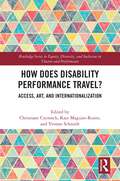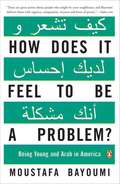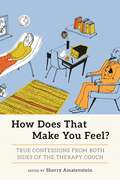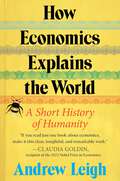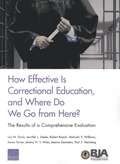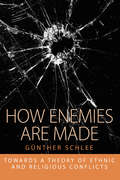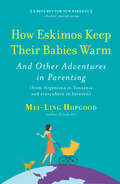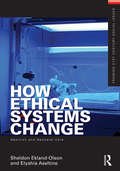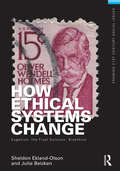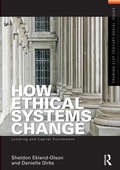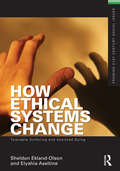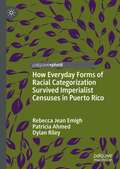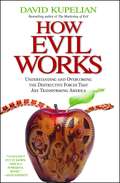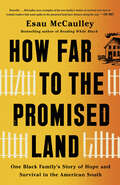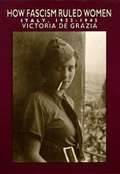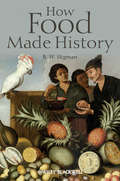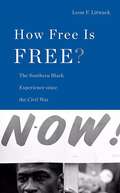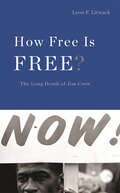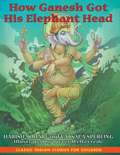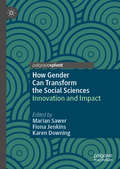- Table View
- List View
How Does Disability Performance Travel?: Access, Art, and Internationalization (Routledge Series in Equity, Diversity, and Inclusion in Theatre and Performance)
by Yvonne Schmidt Christiane Czymoch Kate Maguire-RosierThis edited collection investigates the myriad ways in which disability performance travels in a globalized world. Disability arts festivals are growing in different parts of the world; theatre and dance companies with disabled artists are increasingly touring and collaborating with international partners. At the same time, theatre spaces are often not accessible, and the necessity of mobility excludes some disabled artists from being part of an international disability arts community. How does disability performance travel, who does not travel – and why? What is the role of funding and producing structures, disability arts festivals and networks around the world? How do the logics of international (co-)producing govern the way in which disability art is represented internationally? Who is excluded from being part of a touring theatre or dance company, and how can festivals, conferences, and other agents of a growing disability culture create other forms of participation, which are not limited to physical co-presence? This study will contextualize disability aesthetics, arts, media, and culture in a global frame, yet firmly rooted in its smaller national, state, and local community settings and will be of great interest to students and scholars in the field.
How Does It Feel to Be Old?
by Norma FarberA very old grandmother tells her young granddaughter the positives and negatives of being old. The telling is in rhyme. Descriptions of illustrations included. A short book, very comforting about old age.
How Does It Feel to Be Unwanted?: Stories of Resistance and Resilience from Mexicans Living in the United States
by Eileen Truax Diane StockwellIn an era of increasing anti-immigrant sentiment and bigotry, each of these 13 stories illuminates the issues affecting the Mexican community and shows the breadth of a frequently stereotyped population.Dreamers and their allies, those who care about immigration justice, and anyone interested in the experience of Mexicans in the US will respond to these stories of Mexican immigrants (some documented, some not) illuminating their complex lives. Regardless of status, many are subjected to rights violations, inequality, and violence--all of which existed well before the Trump administration--and have profound feelings of being unwanted in the country they call home. There's Monica Robles, the undocumented mother of three US citizens who is literally confined to a strip of territory between two checkpoints--one at the Mexico border and one twenty-seven miles north of the border. We meet Jeanette Vizguerra, who came to symbolize the sanctuary movement when she took shelter in a Denver church in February 2017 to avoid deportation. (Later that year, Time magazine named her one of the one hundred most influential people in the world.) There's Daniel Rodriguez, the first undocumented immigration lawyer in Arizona to successfully obtain a license to practice. Alberto Mendoza, who suffered persecution as a gay man for years, in 2013 founded Honor 41, a national Latina/o LGBTQ organization that promotes positive images of their community. After crossing the border illegally with his mother as a child, Al Labrada later joined the military to get on a path to citizenship; in March 2017, he was promoted to captain in the Los Angeles Police Department. These and eight other stories will broaden how you think about Mexicans in America.
How Does It Feel to Be a Problem? Being Young and Arab In America
by Moustafa BayoumiAn eye-opening look at how young Arab- and Muslim-Americans are forging lives for themselves in a country that often mistakes them for the enemy. Just over a century ago, W. E. B. Du Bois posed a probing question in his classic The Souls of Black Folk: How does it feel to be a problem? Now, Moustafa Bayoumi asks the same about America's new "problem"--Arab- and Muslim-Americans. Bayoumi takes readers into the lives of seven twenty-somethings living in Brooklyn, home to the largest Arab-American population in the United States. He moves beyond stereotypes and clichés to reveal their often unseen struggles, from being subjected to government surveillance to the indignities of workplace discrimination. Through it all, these young men and women persevere through triumphs and setbacks as they help weave the tapestry of a new society that is, at its heart, purely American.
How Does That Make You Feel?: True Confessions from Both Sides of the Therapy Couch
by Sherry AmatensteinHow Does That Make You Feel? obliterates the boundaries between the shrink and the one being shrunk with unabashedly candid writers breaking confidentiality and telling all about their experiences in therapy. This revelatory, no-punches-pulled book brings to light both sides of the "relationship” between therapist and client-a bond that can feel pure and profound, even if it is, at times, illusory. Contributors include an array of essayists, authors, TV/film writers and therapists, including Patti Davis, Beverly Donofrio, Royal Young, Molly Peacock, Susan Shapiro, Charlie Rubin, Estelle Erasmus, and Dennis Palumbo. Full list of contributors: Sherry Amatenstein Laura Bogart Martha Crawford Patti Davis Megan Devine Beverly Donofrio Janice Eidus Estelle Erasmus Juli Fraga Nina Gaby Mindy Greenstein Jenine Holmes Diane Josefowicz Jean Kim Amy Klein Binnie Klein Anna March Allison McCarthy Kurt Nemes Dennis Palumbo Molly Peacock Pamela Rafalow Grossman Charlie Rubin Jonathan Schiff Barbara Schoichet Adam Sexton Susan Shapiro Beth Sloan Eve Tate Kate Walter Priscilla Warner Linda Yellin Royal Young Jessica Zucker
How Economics Explains the World: A Short History of Humanity
by Andrew Leigh“If you read just one book about economics, make it Andrew Leigh's clear, insightful, and remarkable (and short) work.” —Claudia Goldin, recipient of the 2023 Nobel Prize in Economics and Henry Lee Professor of Economics at Harvard UniversityA sweeping, engrossing history of how economic forces have shaped the world—all in under 200 pagesIn How Economics Explains the World, Harvard-trained economist Andrew Leigh presents a new way to understand the human story. From the dawn of agriculture to AI, here is story of how ingenuity, greed, and desire for betterment have, to an astonishing degree, determined our past, present, and future. This small book indeed tells a big story. It is the story of capitalism – of how our market system developed. It is the story of the discipline of economics, and some of the key figures who formed it. And it is the story of how economic forces have shaped world history. Why didn’t Africa colonize Europe instead of the other way around? What happened when countries erected trade and immigration barriers in the 1930s? Why did the Allies win World War II? Why did inequality in many advanced countries fall during the 1950s and 1960s? How did property rights drive China’s growth surge in the 1980s? How does climate change threaten our future prosperity? You’ll find answers to these questions and more in How Economics Explains the World.
How Effective Is Correctional Education, and Where Do We Go from Here?: The Results of a Comprehensive Evaluation
by Lois M. Davis Malcolm V. Williams Jessica Saunders Jennifer L. Steele Jeremy N. V. Miles Robert Bozick Susan Turner Paul S. SteinbergThis report assesses the effectiveness of correctional education programs for both incarcerated adults and juveniles and the cost-effectiveness of adult correctional education. It also provides results of a survey of U. S. state correctional education directors that give an up-to-date picture of what correctional education looks like today. Finally, the authors offer recommendations for improving the field of correctional education moving forward.
How Enemies Are Made
by Günther SchleeIn popular perception cultural differences or ethnic affiliation are factors that cause conflict or political fragmentation although this is not borne out by historical evidence. This book puts forward an alternative conflict theory. The author develops a decision theory which explains the conditions under which differing types of identification are preferred. Group identification is linked to competition for resources like water, territory, oil, political charges, or other advantages. Rivalry for resources can cause conflicts but it does not explain who takes whose side in a conflict situation. This book explores possibilities of reducing violent conflicts and ends with a case study, based on personal experience of the author, of conflict resolution.
How Eskimos Keep Their Babies Warm: And Other Adventures in Parenting (from Argentina to Tanzania and Everywhere in Between)
by Mei-Ling HopgoodA “breezy and entertaining” tour of parenting practices around the world that shows there’s more than one way to diaper a baby (The Boston Globe). Mei-Ling Hopgood, a first-time mom from suburban Michigan—now living in Buenos Aires—was shocked that Argentine parents allowed their children to stay up until all hours of the night. Could there really be social and developmental advantages to this custom? Driven by a journalist’s curiosity (and a new mother’s desperation for answers), Hopgood embarked on a journey to learn how other cultures approach the challenges all parents face: bedtimes, toilet training, feeding, teaching, and more. Observing parents around the globe and interviewing anthropologists, educators, and child-care experts, she discovered a world of new ideas. The Chinese excel at potty training, teaching their wee ones as young as six months old. Kenyans wear their babies in colorful cloth slings—not only is it part of their cultural heritage, but strollers seem outright silly on Nairobi’s chaotic sidewalks. And the French are experts at turning their babies into healthy, adventurous eaters. Hopgood tested her discoveries on her spirited toddler, Sofia, with some enlightening results. This look at the ways other cultures raise children offers parents the option of experimenting with tried and true methods—and reveals that there are a surprising number of ways to be a good parent. “Hopgood is charmingly self-deprecating about her own mothering of the formidable Sofia, who emerges as a sassy character in her own right.” —The Boston Globe “A best bet for new parents.” —Booklist, starred review
How Ethical Systems Change: Abortion and Neonatal Care (Framing 21st Century Social Issues)
by Sheldon Ekland-Olson Elyshia AseltineRoe v. Wade came like a bolt from the blue, but support had been building for years. For many, the idea that life in the womb was not fully protected under the Constitution was simply not acceptable. Political campaigns were organized and protests launched, including the bombing of clinics and the killing of abortion providers. Questions about the protection and support of life continued after birth. This book is based on a hugely popular undergraduate course taught at the University of Texas, and is ideal for those interested in the social construction of social worth, social problems, and social movements. This book is part of a larger text, Who Lives, Who Dies, Who Decides?, http://www.routledge.com/books/details/9780415892476/
How Ethical Systems Change: Eugenics, the Final Solution, Bioethics (Framing 21st Century Social Issues)
by Sheldon Ekland-Olson Julie BeickenMandatory sterilization laws enacted in dozens of states coast-to-coast and approved by the U.S. Supreme Court formed the initial pillar for what became the Final Solution. Following WWII, there was renewed interest in a more inclusive view of social worth and the autonomy of the individual. Social movements were launched to secure broad-based revisions in civil and human rights. This book is based on a hugely popular undergraduate course taught at the University of Texas, and is ideal for those interested in science-based policy, the social construction of social worth, social problems, and social movements. This book is an excerpt from a larger text, Who Lives, Who Dies, Who Decides?, http://www.routledge.com/9780415892476/
How Ethical Systems Change: Lynching And Capital Punishment (Framing 21st Century Social Issues)
by Sheldon Ekland-Olson Danielle DirksSlavery, lynching and capital punishment were interwoven in the United States and by the mid-twentieth century these connections gave rise to a small but well-focused reform movement. Biased and perfunctory procedures were replaced by prolonged trials and appeals, which some found messy and meaningless; DNA profiling clearly established innocent persons had been sentenced to death. The debate over taking life to protect life continues; this book is based on a hugely popular undergraduate course taught at the University of Texas, and is ideal for those interested in criminal justice, social problems, social inequality, and social movements. This book is an excerpt from a larger text, Who Lives, Who Dies, Who Decides?, http://www.routledge.com/9780415892476/
How Ethical Systems Change: Tolerable Suffering And Assisted Dying (Framing 21st Century Social Issues)
by Sheldon Ekland-Olson Elyshia AseltineMedical advances prolong life. They also sometimes prolong suffering. Should we protect life or alleviate suffering? This dilemma formed the foundation for a powerful right-to-die movement and a counterbalancing concern over an emerging culture of death. What are the qualities of a life worth living? Where are the boundaries of tolerable suffering? This book is based on a hugely popular undergraduate course taught at the University of Texas, and is ideal for those interested in the social construction of social worth, social problems, and social movements. This book is part of a larger text, Who Lives, Who Dies, Who Decides?, http://www.routledge.com/9780415892476/
How Everyday Forms of Racial Categorization Survived Imperialist Censuses in Puerto Rico
by Dylan Riley Rebecca Jean Emigh Patricia AhmedThis book examines the history of racial classifications in Puerto Rico censuses, starting with the Spanish censuses and continuing through the US ones. Because Puerto Rican censuses were collected regularly over hundreds of years, they are fascinating “test cases” to see what census categories might have been available and effective in shaping everyday ones. Published twentieth-century censuses have been well studied, but this book also examines unpublished documents in previous centuries to understand the historical precursors of contemporary ones. State-centered theories hypothesize that censuses, especially colonial ones, have powerful transformative effects. In contrast, this book shows that such transformations are affected by the power and interests of social actors, not the strength of the state. Thus, despite hundreds of years of exposure to the official dichotomous and trichotomous census categories, these categories never replaced the continuous everyday ones because the census categories rarely coincided with Puerto Rican’s interests.
How Evil Works
by David KupelianDavid Kupelian, veteran journalist and bestselling author of The Marketing of Evil, probes the millennia-old questions of evil--what it is, how it works, and why it so routinely and effortlessly ruins our lives--once again demonstrating his uncanny knack for demystifying complex, elusive, and intimidating subjects with fresh insights into the hidden mechanisms of seduction, corruption, religion, and power politics. Analyzing today's most electrifying news stories and hot-button topics, Kupelian explores such profoundly troubling questions asWhy are big lies more believable than little ones?How does terrorism really work?Why do so many celebrities who "have it all" end up self-destructing?Why are boys doing worse in school today than girls?Why do we treat the problems of anger and depression with drugs?. . . and much more. Fortunately, once we really understand "how evil works"--both in our own lives and in the world at large--evil loses much of its power and the way out becomes more clear.
How Evil Works: Understanding and Overcoming the Destructive Forces That Are Transforming America
by David KupelianDavid Kupelian, veteran journalist and bestselling author of The Marketing of Evil, probes the millennia-old questions of evil--what it is, how it works, and why it so routinely and effortlessly ruins our lives--once again demonstrating his uncanny knack for demystifying complex, elusive, and intimidating subjects with fresh insights into the hidden mechanisms of seduction, corruption, religion, and power politics. Analyzing today's most electrifying news stories and hot-button topics, Kupelian explores such profoundly troubling questions asWhy are big lies more believable than little ones?How does terrorism really work?Why do so many celebrities who "have it all" end up self-destructing?Why are boys doing worse in school today than girls?Why do we treat the problems of anger and depression with drugs?. . . and much more. Fortunately, once we really understand "how evil works"--both in our own lives and in the world at large--evil loses much of its power and the way out becomes more clear.
How Far Have We Come in Reducing Health Disparities?
by Karen M. AndersonAt the turn of the 21st century, several important reports and events designed to raise awareness of health disparities and to describe initial efforts to reduce health disparities took place. The Surgeon General's office released several reports that showed dramatic disparities in tobacco use and access to mental health services by race and ethnicity. The first real legislation focused on reducing health disparities was signed into law, creating the National Center for Minority Health and Health Disparities within the NIH. In 2001, the IOM released its landmark report, Crossing the Quality Chasm: A New Health System for the 21st Century, highlighting the importance of a focus on health care quality rather than a focus on only access and cost issues. Building upon these reports and events, the IOM held a workshop on April 8, 2010, that discussed progress to address health disparities and focused on the success of various federal initiatives to reduce health disparities. How Far Have We Come in Reducing Health Disparities? summarizes the workshop and explains the progress in the field since 2000.
How Far to the Promised Land: One Black Family's Story of Hope and Survival in the American South
by Esau McCaulleyFrom the New York Times contributing opinion writer and award-winning author of Reading While Black, a riveting intergenerational account of his family&’s search for home and hope&“A riveting book that invites you into the personal journey of one of the finest writers alive today.&”—Beth Moore, New York Times bestselling author of All My Knotted-Up Life For much of his life, Esau McCaulley was taught to see himself as an exception: someone who, through hard work, faith, and determination, overcame childhood poverty, anti-Black racism, and an absent father to earn a job as a university professor and a life in the middle class. But that narrative was called into question one night, when McCaulley answered the phone and learned that his father—whose absence defined his upbringing—died in a car crash. McCaulley was being asked to deliver his father&’s eulogy, to make sense of his complicated legacy in a country that only accepts Black men on the condition that they are exceptional, hardworking, perfect. The resulting effort sent McCaulley back through his family history, seeking to understand the community that shaped him. In these pages, we meet his great-grandmother Sophia, a tenant farmer born with the gift of prophecy who scraped together a life in Jim Crow Alabama; his mother, Laurie, who raised four kids alone in an era when single Black mothers were demonized as &“welfare queens&”; and a cast of family, friends, and neighbors who won small victories in a world built to swallow Black lives. With profound honesty and compassion, he raises questions that implicate us all: What does each person&’s struggle to build a life teach us about what we owe each other? About what it means to be human? How Far to the Promised Land is a thrilling and tender epic about being Black in America. It&’s a book that questions our too-simple narratives about poverty and upward mobility; a book in which the people normally written out of the American Dream are given voice.
How Fascism Ruled Women: Italy, 1922-1945
by Victoria De Grazia"Italy has been made; now we need to make the Italians, " is a long-familiar Italian saying. Mussolini was the first head of government to include women in this mandate. What the fascist dictatorship expected of its female subjects and how they experienced the Duce's brutal but seductive rule are the main topics of Victoria de Grazia's new book. The author draws on an unusual array of sources--memoirs, novels, and reports on the images and events of mass culture, as well as government statistics and archival accounts--to present a broad yet detailed characterization of Italian women's ambiguous and ambivalent experience of a regime that promised women modernity, yet denied them freedom. Always attentive to the great diversity among women and careful to distinguish fascist rhetoric from the practices actually shaping daily existence, de Grazia moves with ease from the public discourse about maternity and family life to the images of femininity in commercial culture. The first study of women's experience under Italian fascism, this book offers a compelling treatment of the making of contemporary Italian society. With acute comparisons between the sexual politics of Italian fascism and developments elsewhere, including Hitler's Germany, de Grazia illuminates trends and dilemmas common to the construction of female citizenship in twentieth-century societies.
How Food Made History
by B. W. HigmanCovering 5,000 years of global history, How Food Made History traces the changing patterns of food production and consumption that have molded economic and social life and contributed fundamentally to the development of government and complex societies. Charts the changing technologies that have increased crop yields, enabled the industrial processing and preservation of food, and made transportation possible over great distances Considers social attitudes towards food, religious prohibitions, health and nutrition, and the politics of distribution Offers a fresh understanding of world history through the discussion of food
How Forests Think: Toward an Anthropology Beyond the Human
by Eduardo KohnCan forests think? Do dogs dream? In this astonishing book, Eduardo Kohn challenges the very foundations of anthropology, calling into question our central assumptions about what it means to be human—and thus distinct from all other life forms. Based on four years of fieldwork among the Runa of Ecuador’s Upper Amazon, Eduardo Kohn draws on his rich ethnography to explore how Amazonians interact with the many creatures that inhabit one of the world’s most complex ecosystems. Whether or not we recognize it, our anthropological tools hinge on those capacities that make us distinctly human. However, when we turn our ethnographic attention to how we relate to other kinds of beings, these tools (which have the effect of divorcing us from the rest of the world) break down. How Forests Think seizes on this breakdown as an opportunity. Avoiding reductionistic solutions, and without losing sight of how our lives and those of others are caught up in the moral webs we humans spin, this book skillfully fashions new kinds of conceptual tools from the strange and unexpected properties of the living world itself. In this groundbreaking work, Kohn takes anthropology in a new and exciting direction–one that offers a more capacious way to think about the world we share with other kinds of beings.
How Free Is Free? The Long Death of Jim Crow
by Leon F. LitwackIn 1985, a black veteran of the civil rights movement offered a bleak vision of a long and troubled struggle. For more than a century, black southerners learned to live with betrayed expectations, diminishing prospects, and devastated aspirations. Their odyssey includes some of the most appalling examples of terrorism, violence, and dehumanization in the history of this nation. But, as Leon Litwack graphically demonstrates, it is at the same time an odyssey of resilience and resistance defined by day-to-day acts of protest: the fight for justice poignantly recorded in the stories, songs, images, and movements of a people trying to be heard. For black men and women, the question is: how free is free? Despite two major efforts to reconstruct race relations, injustices remain. From the height of Jim Crow to the early twenty-first century, struggles over racism persist despite court decisions and legislation. Few indignities were more pronounced than the World War II denial of basic rights and privileges to those responding to the call to make the world safe for democratic values that they themselves did not enjoy. And even the civil rights movement promise to redeem America was frustrated by change that was often more symbolic than real. Although a painful history to confront, Litwack's book inspires as it probes the enduring story of racial inequality and the ongoing fight for freedom in black America with power and grace.
How Free Is Free?: The Long Death of Jim Crow (The Nathan I. Huggins lectures)
by Leon F. LitwackIn 1985, a black veteran of the civil rights movement offered a bleak vision of a long and troubled struggle. For more than a century, black southerners learned to live with betrayed expectations, diminishing prospects, and devastated aspirations. Their odyssey includes some of the most appalling examples of terrorism, violence, and dehumanization in the history of this nation. But, as Leon Litwack graphically demonstrates, it is at the same time an odyssey of resilience and resistance defined by day-to-day acts of protest: the fight for justice poignantly recorded in the stories, songs, images, and movements of a people trying to be heard.For black men and women, the question is: how free is free? Despite two major efforts to reconstruct race relations, injustices remain. From the height of Jim Crow to the early twenty-first century, struggles over racism persist despite court decisions and legislation. Few indignities were more pronounced than the World War II denial of basic rights and privileges to those responding to the call to make the world safe for democratic values—values that they themselves did not enjoy. And even the civil rights movement promise to redeem America was frustrated by change that was often more symbolic than real.Although a painful history to confront, Litwack’s book inspires as it probes the enduring story of racial inequality and the ongoing fight for freedom in black America with power and grace.
How Ganesh Got His Elephant Head
by Harish Johari Vatsala SperlingRelates adventures of Ganesh, the Hindu god of prosperity, and how he became the gods' gift to humanity.
How Gender Can Transform the Social Sciences: Innovation and Impact
by Karen Downing Marian Sawer Fiona JenkinsThis collection turns a spotlight on gender innovation in the social sciences. Eighteen short and accessibly written case studies show how feminist and gender perspectives bring new concepts, theories and policy solutions. Scholars across five disciplines– economics, history, philosophy, political science and sociology – demonstrate how paying attention to gender can sharpen the focus of the social sciences, improve the public policy they inform, and change the way we measure things. Gender innovation provokes rethinking at both the core and the margins of established disciplines, sometimes developing alternative fields of research that chart new territory. These case studies celebrate the contribution of feminist and gender scholars and span topics ranging from budgeting, electoral systems and security studies to the ethics of care, emotional labor and climate change.
